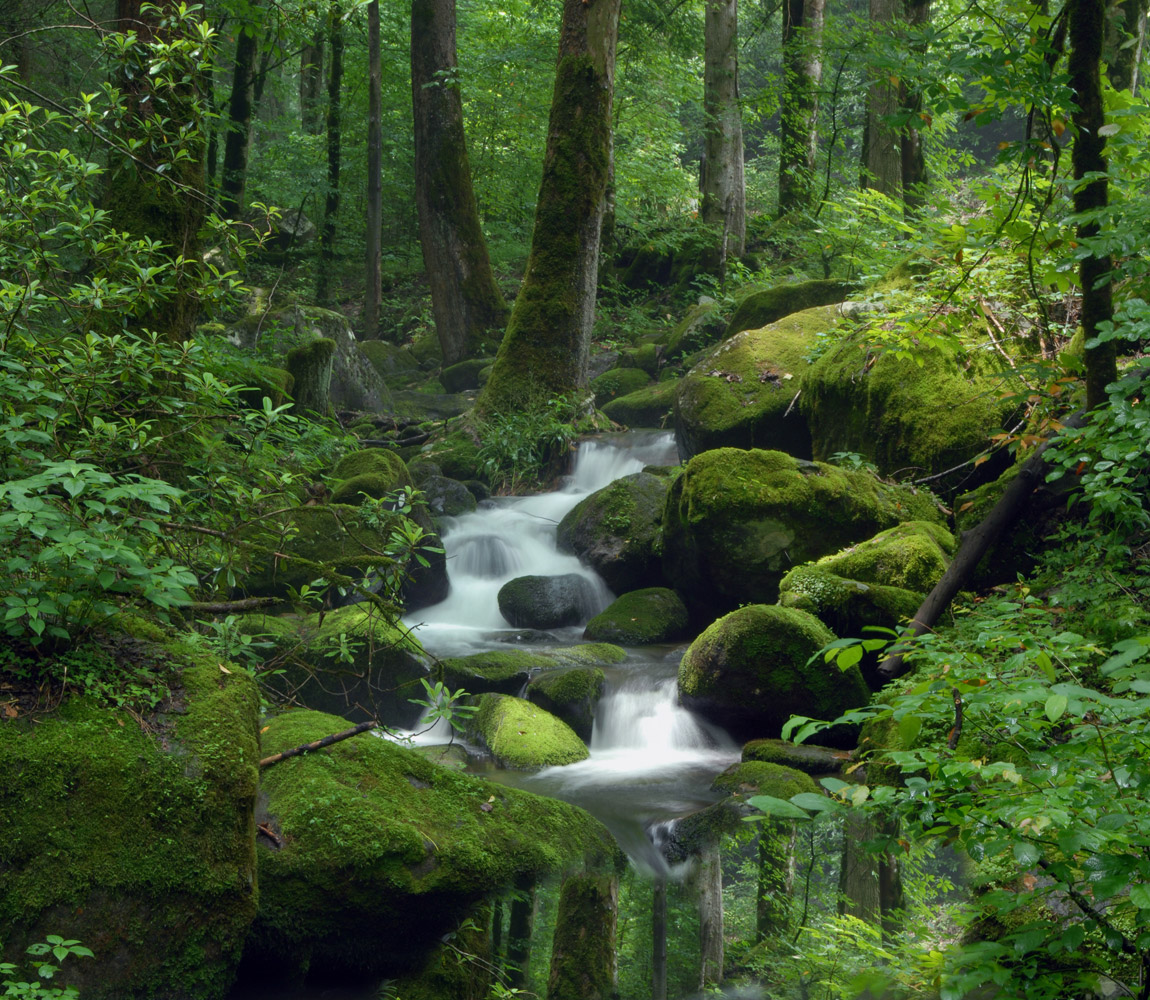Young Birders Series – Pelagic Birding – 9.04-05 2023
Birding while at Sea: 24 hours on the American Princess Cruise
The black night sky slowly took on the first hints of blue as the sun emerged, casting varying shades of pink and orange over the horizon. As we emerged from our slumber and took our places on the deck of the American Princess Cruise, the first birds of the day came into view: frisky Wilson’s Storm Petrels (the house finches of the sea), swooping, swallow-like, across the waves followed shortly thereafter by a Band-rumped Storm Petrel. Although the Band-rumped preferred to distance itself from our boat and remain obscured from great views, the frisky Wilson’s Storm Petrels allowed for fantastic photographic opportunities. Great Shearwaters glided across the glassy and still depths of the ocean, albatross-like, with the occasional Cory’s (Shearwater) in tow. The Shearwaters, both Great and Cory’s, classified in the family “Procellariidae”, summer in the North Atlantic and tend to forage in flocks. On that day, they stayed true to this behavior by feeding close to our boat on fish and squid being thrown overboard. Soon thereafter, the acrobats of the ocean, Wilson’s Storm Petrels, again appeared and remained at our side, or should I say starboard and port.
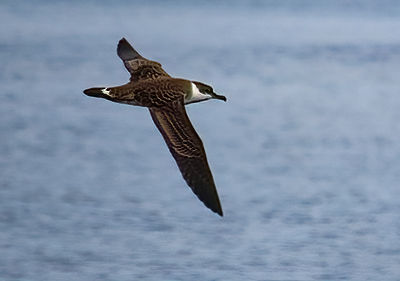
Great Shearwater – ©Arabella Pajoohi
For much of the morning, our avian sightings remained largely unchanged: Wilson’s Storm Petrels, Cory’s Shearwater, and Great Shearwater. Then, we had our first cetacean spotting of the day; a pod of Atlantic Spotted Dolphins took turns surfing in the waves of our boat, a silvery calf leaping with them. After crossing under our boat multiple times, these highly social cetaceans continued to entertain us with aerial feats and then, deciding that they had had their fill of play, continued on their travels.
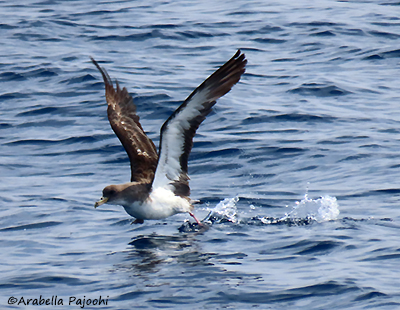
Cory’s Shearwater – ©Arabella Pajoohi
A cry went up, suddenly: Long-tailed Jaeger! We frantically dashed from port to stern, stern to starboard, and every way we could. Some of us, including me, dashed up the stairs to the top deck for photos as the Jaeger flew over. It was thrown some chum, which it happily gobbled and then flew away, chum dangling from its beak. Shortly thereafter, the lure of chum being too irresistible, the Jaeger returned, and we once again dashed about frantically, seeking glimpses. What a sight we must have been to it, and to all creatures out there; at this point, each time it flew over, we ran about, clasping the railings for footing, running and shuffling along while trying to be mindful of our gear and one another.
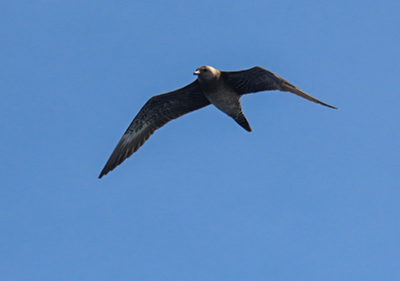
Long-tailed Jaeger ©Arabella Pajoohi
Suddenly, a shorebird flew over us, uttering a cry. It turned out to be a Whimbrel!! For a bit, all was quiet, and then the ocean had another rare treat in store for us: “White-faced Storm Petrel!” We watched as the White-faced flew in, bouncing off the waves as if the ocean itself were one mighty trampoline. After the White-faced departed, the Wilson’s Storm Petrels flew in once again, dashing about and careening over the waves, followed by a pod of Common Dolphins and then Bottlenose. Soon thereafter, Sperm Whales and Pilot Whales captured our attention, both pods accompanied by calves.
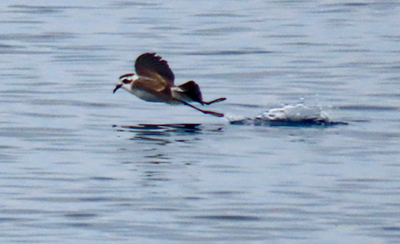
White-faced Storm Petrel
©Arabella Pajoohi
Two Common Terns standing side by side on a floating log amid a patch of Sargassum floated by, with the Terns using the log as a rest stop where they could preen and stretch. Sargassum, also known as a floating hydrophyte, or free floater, floats freely through the ocean and supports a large diversity of marine life, including more than 100 species of fish, more than 100 species of invertebrates, and four species of sea turtles. Migratory birds, such as the Common Tern, often use Sargassum mats to feed from, and perhaps this was the case here as well.
As the waves quieted, Wilson’s Storm Petrels skimmed the gently lapping waves, and Risso’s Dolphins emerged, their sides painted with what looked like nicks and cuts (don’t worry, this is how their skin appears).
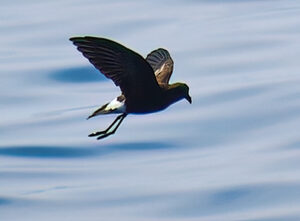
Wilson’s Storm Petrel – ©Arabella Pajoohi
Common Dolphins arrived shortly after the departure of the Risso’s, spraying water as they played. Then, the chip note of a small passerine caught the attention of our ears – a Yellow Warbler – followed by a Flycatcher species that remained unidentified. Near the horizon, a Little Brown Bat fluttered and flapped, and then, as Green darners and unidentifiable moths fluttered by, the little bat flew directly over our heads and over the top deck! Bat sightings across the ocean have been recorded since at least 1890, although science is only beginning to understand the migratory patterns of bats across open oceans.
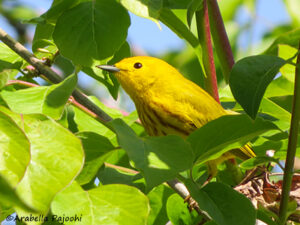
Yellow warbler ©Arabella Pajoohi
Movement in the distance caught the eye of a trip leader who “walkied” it to the crew. Technology sometimes fails us when we need it, and in this case, it did just that; the walkie talkie died before the alert went out. The movement in the distance turned out to be Red-necked Phalaropes, an Arctic breeding bird that I have been hoping to see for some time. The ocean and the skies stilled themselves again, and some of used this opportunity to cure our disappointment at missing this species and take a much needed mid-afternoon nap (birding can be exhausting!).
Late afternoon waves brought forth Loggerhead Sea Turtles who peaked their heads up and then disappeared into the depths. Hammerhead Sharks meandered nearby, showcasing their fins and impressive tails, while Wilson’s Storm Petrels accompanied us on our voyage back to shore. As the sun began to set, casting its orange, red, and violet rays across the ocean, city lights greeted us along with the squawks of Lesser-blacked Gulls and Herring Gulls. As we approached shore, Mute Swans appeared on either side of our boat, guiding us to port.
Birding the sea is unlike any other form of birding and experience. As others have written, there is something magical about traveling the open ocean, observing birds who are undertaking what would seem to be improbable feats to survive in what continues to be a more challenging and inhospitable world. That evening, as we returned to Sheepshead Bay, Brooklyn, the ocean presented us with a final gift: a Black-crowned Night Heron, sitting half-hidden in the shadows of the dock, welcomed us back to land and bid us farewell from the seas.
Good birding,
Arabella Pajoohi
New York State Young Birders Club
